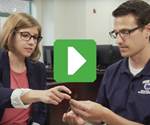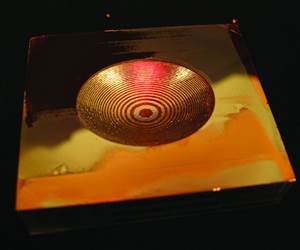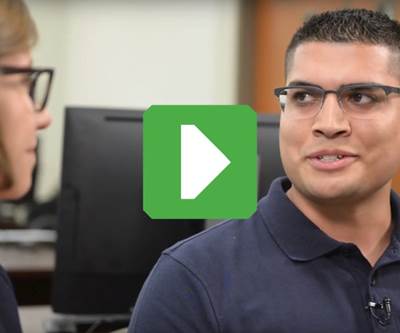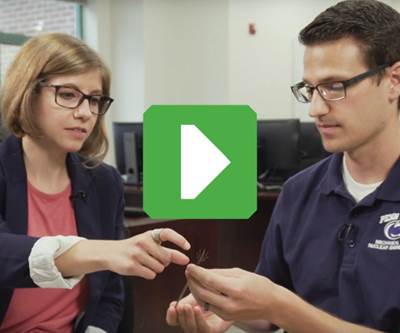Video: Inside the Penn State Additive Manufacturing Master's Program, Part 4
Kevin White, mechanical engineer at the Naval Nuclear Lab and student at Penn State, shares how a higher education in AM provides benefits beyond technical training.
When Penn State launched a master’s degree in additive manufacturing and design in 2017, the program was unusual for several reasons. First, it was one of the first higher education degrees in AM in the United States. Second, PSU elected to offer two tracks: an online offering, alongside the conventional on-campus option.
Online students like Kevin White benefit from the online option because it allows them to continue working full time while completing the master’s degree. But the face-to-face benefits of a campus experience are not lost; online students regularly interact with their peers digitally and also complete a one-week hands-on lab at Penn State.
I met up with White in the midst of this lab week for the interview below, in which he describes what it’s like to participate in the online curriculum, and both the skills and networking benefits of the program. Watch below or read on for the transcript.
Video Transcript
Stephanie Hendrixson, Additive Manufacturing Magazine
I’m Stephanie Hendrixson with Additive Manufacturing Magaine. I'm here at Penn State, home of one of the nation's first master's degree programs in additive manufacturing and design. One of the unique things about this program is that while there's a traditional in-person track, there's also an online option for students who are currently in the workforce that involves a hands-on lab component here at Penn State. I'm here with Kevin White, a mechanical engineer at the Naval Nuclear Lab who's currently a student in this program. Given your experience in undergrad and the work that you do now, what brings you to Penn State to pursue a master's degree in additive manufacturing (AM)?
Kevin White, Naval Nuclear Lab
Primarily, the technology is just constantly growing and constantly evolving. For me, that's very exciting—being able to work in the industry while still taking classes and partaking a little bit in the research and constant evolution of AM. As you know, it is just a great opportunity that I'm excited to be a part of.
Stephanie
You've been taking classes online and this is your first time on campus here at Penn State. What's the experience been like between the online and the in-person components?
Kevin
Online is what it sounds like, it's all online. There are lectures, videos, quizzes, etc. Being on site, they do a great job of really getting you exposed to the labs available, getting your hands on the equipment, on the machines, on the prints.
Stephanie
What's one surprising or particularly valuable lesson that you've learned while in this program?
Kevin
I think the most surprising aspect to me was just the variety of students that are in the program. We have people that are management level that are coming to learn more about AM, and then we have people like me who have only been working in the industry for a year or two now.
Stephanie
So there's that educational aspect, there’s the skills-building aspect, but then there's also kind of a networking aspect where you're getting to meet people who work in different industries and in different types of jobs.
Kevin
Yeah, exactly, and just being here to work with managers from GE or from West Coast engineers who are working for the DOD instead of the DOE. So, it's been a great experience getting to see how they are applying AM in their own businesses.
Stephanie
What are you going to take away from this program and how are you going to bring that back to your workplace?
Kevin
The Naval Nuclear Lab has a Pittsburgh branch, which is where I currently work. So first and foremost, I'm excited to bring back just the facilities that are available to us that are relatively close distance: the equipment, the machines, just the technical capability that Penn State has to offer that we as a company might be able to take advantage of. Second, I'm hoping to bring back the knowledge that I've gained through this experience, whether it's the software that we've seen that we can try to implement in our own company or the physical design mechanisms that are being taught here. I'm hoping to bring that back to the company.
Stephanie
Given your experience here in this program where do you think AM is going to go both in your own industry and kind of broadly going forward?
Kevin
I think AM is disrupting a lot of industries where we do things conventionally. We're now starting to think twice about whether or not we can use AM to completely change the technology. I know our company is just still evaluating how we can use the technology fully to better support the Navy. And I know, whether you're in aerospace, medical or even just toys now, prototyping is such a huge area of AM, which is allowing a lot of smaller companies to enter into the market. Where maybe a smaller company couldn't afford the initial upfront costs of traditional manufacturing, with all the forgings and all of the more expensive upfront costs, AM gives them a foot in the door that kind of equalizes the playing ground and lets a lot of smaller companies enter in and I think the result of that will be a lot more competition which will drive AM. I think it'll be a lot more innovation from smaller companies that are trying to get their name out and advance. Overall, I just think it'll provide better products in every industry.
Related Content
3D Printing with Plastic Pellets – What You Need to Know
A few 3D printers today are capable of working directly with resin pellets for feedstock. That brings extreme flexibility in material options, but also requires greater knowledge of how to best process any given resin. Here’s how FGF machine maker JuggerBot 3D addresses both the printing technology and the process know-how.
Read MorePostprocessing Steps and Costs for Metal 3D Printing
When your metal part is done 3D printing, you just pull it out of the machine and start using it, right? Not exactly.
Read MoreAM 101: What is Ultrasonic Additive Manufacturing?
Going from additive to subtractive can be simple with Ultrasonic Additive Manufacturing (UAM). What is it and how does it work? Learn the basics in this 101 post.
Read MoreHow to Build 10,000+ Shot Molds in Hours
Rapid tooling isn’t so rapid when it takes days to 3D print a metal mold, and then you still must machine it to reach the necessary tolerances. With Nexa3D’s polymer process you can print a mold in hours that is prototype or production ready and can last for more than 10,000 shots.
Read MoreRead Next
Video: Inside the Penn State Additive Manufacturing Master's Program, Part 3
Alan Suarez Garcia, advanced manufacturing engineer at GE Healthcare and master's student at Penn State, explains how this degree program changes how he looks at manufacturing.
Read MoreVideo: Inside the Penn State Additive Manufacturing Master's Program, Part 2
A conversation with Brad Hanks, Ph.D. student at Penn State University, illustrates the intersection of optimization and AM with the example of an electrode for cancer treatment surgery.
Read MoreInside the Penn State Additive Manufacturing Master’s Program, Part 1
PSU's engineering master's degree in additive manufacturing and design offers students and manufacturing professionals a higher education in a continuously maturing field.
Read More
.jpg;width=70;height=70;mode=crop)










.png;maxWidth=300;quality=90)











